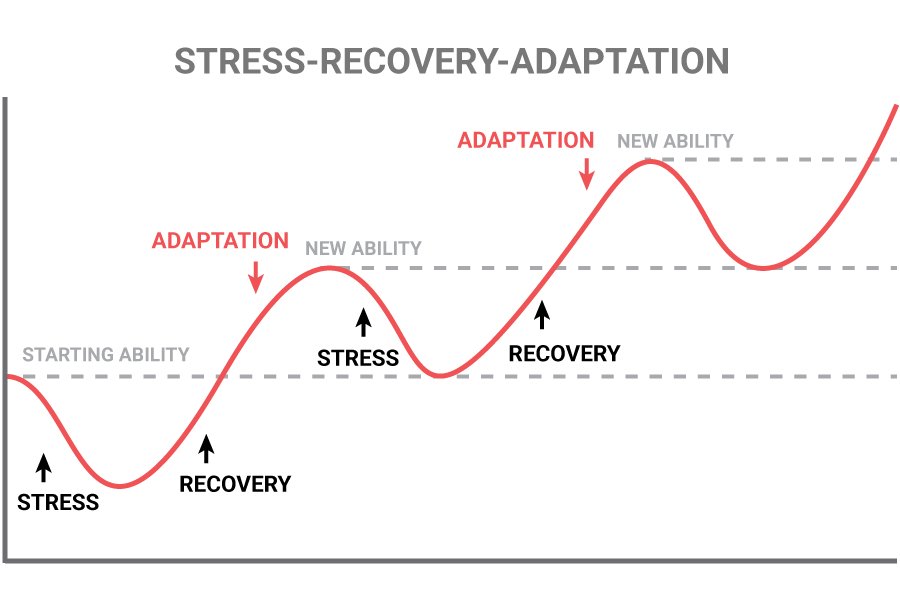4 Key Principles Of Fitness Training
July 7, 2022

Last Blog we talked about the first 4 Principles of Training. These last 4 are the trickier ones to get your head around, and the reason why a qualified and experienced professional should be designing your programs.
1. Recovery:
Proper rest is needed between training sessions for the body to adapt to the stimulus, failure to adequately rest often leads to overuse injuries, fatigue and reduced performance (Corbin et.al 2013, p. 87). When doing full body workouts, a minimum day on day off approach is often needed to allow muscles to recover adequately.
You can still train on these in-between days with cardio, classes, or by working muscles that you haven’t exhausted in the recent workout. Split routines that work different muscles on different days is how you back-to-back resistance days. Remember, your objective of each workout is to stress muscles so they adapt and super-compensate to come back stronger, adequate recovery is needed for this to happen.
2.Reversibility:
Any benefits gained will gradually diminish, if regular engagement is not maintained (Corbin et.al 2013, p. 86). After 12 weeks of detraining, subjects (20-30 and 65-75 yrs) found no significant strength losses from 9 weeks of strength training gains, at 31 weeks they found 8% and 13% losses. Muscular endurance decreases after only two weeks of inactivity. Sprint performance is unaffected by 1 month of inactivity, however endurance events decrease significantly in as little as two weeks (four weeks of detraining has shown to decrease muscle glycogen (energy stores) by 40%, and blood lactate concentrations increase week to week during a month of inactivity.
A 20 day period of bedrest shows an increase in submaximal heart rate exercise, 25% decrease in stroke volume, 25% decrease in cardiac output and 27% decrease in maximal oxygen consumption. Untrained people regain initial conditioning levels in 10 days of reconditioning, well trained subjects needed 40 days for full recovery. Training 3 times per week at 70% VO2max is necessary to maintain aerobic capacity, losses are significant when frequency and duration are reduced by 2/3rds of the regular training load (Kenny, Wilmore & Costill 2012 p. 349).
3.Rate Of Diminishing Returns:
The rate of improvement levels off as you get fitter. You will not continue to get as larger benefit for each additional amount of activity you perform (Corbin et.al p. 87). A great proportion of strength gains can be accomplished with 2 days of training per week, an additional 3rd day results in additional increases but the amount of gain is relatively small compared with results from 2 days (Corbin et.al 2013, p. 168). Research shows that considerable fitness and health benefits can be achieved in your first set – approximately 50%, each additional set produces additional benefits but not as much as the preceding set. (Corbin et.al 2013, p. 172).

4. Variation / Periodisation:
“The systematic process of changing one or more variables in the training mode, to allow the training stimulus to remain challenging and effective“ (Kenny, Wilmore & Costill 2012 p. 216). According to Kraemer (2008) mesocycles (modes of training) with a specific objective should endure for approximately 4-8 weeks and start with a general preparation phase before becoming more specific.
A person with minimal to no resistance experience (young training age) has a larger range for adaption than a well-trained individual (this person is closer to their genetic potential and often adapts to a training stimulus more quickly). The time required to produce a measurable and relatively stable adaption is usually between 4-6 weeks (Naclerio, Moody & Chapman 2013, Jones 2015).
Duration of a mesocycle should be dictated by a clients’ goals, compliance level and physical ability. ‘Typically, a phase of training will last 4-6 weeks, as this is the amount of time it generally takes for the body to adapt to a given stimulus’ (Kirckof 2012). Therefore, you should aim to engage in a progressive training regime with similar reps, sets and tempo ranges for a minimum of 4 weeks and roll into a different regime around the 6-8 week mark. If you love a specific style or mode of training, because you feel it gives you great results. Don’t stay with it for 6 months, cycle a different program in for 4-8 weeks, then roll back to it again and you will continue to get great results from it, rather than plateau.
After each mesocycle has been completed, this is a good time for an analysis to be conducted (SWOT).
- Strengths – What are the positives I’m getting from the program and why
- Weaknesses – What are the down sides of the program
- Opportunities – Is the program lacking anything, what changes would further enhance it
- Threats – Were there any potentially risky aspects, what training variables are neglected in this mode that I should consider (this may help steer you into the next mode of training).
There you have it, 8 principals of training that govern program design! All aspects should be/are considered by the exercise professionals designing your training regimes. With years of trial, error and continual modifications, trainers get better and better at designing programs that take into account these training principals, to fast track and optimise training outcomes whilst reducing injury risks.

Leave a Reply